Introduction
Farrow and Ball is a British company that manufactures and sells a variety of paints and wallpapers. It was founded by John Farrow and Richard Maurice Ball in 1946 in Dorset. The company is known for working with well-known and well-established brands such as Ford Motor Company. They also take pride in participating in the renovation of the architectural buildings, creating unique paints matching the original colors.
Farrow and Ball identify themselves as a brand that is true to its historical roots, traditions, manufacturing methods, and finest quality materials. Today, the company operates in 37 countries selling and advertising its products through its 60 showrooms and stores as well as a website. Farrow and Ball are rather profitable, as its revenues reached 59 million pounds in 2016 (Dakers). In this paper, the brand audit will be conducted through the analysis of the brand inventory and brand exploratory to propose a suitable brand development strategy.
Brand Exploratory
Even though Farrow and Ball operate globally and partner with multiple stockists, there is a strong British touch in every product. In addition to that, the company representatives argue that they always remember their Dorset origin (Our History). Farrow and Ball’s brand position can be identified through its target audience, brand meaning, elements, and other items.
Target Audience
The products that the company manufactures are intended mostly for home decoration. Therefore, the audience that may be interested in such products should consist mainly of individuals and couples that demonstrate the intention of decorating or re-decorating their house. Most likely, a typical customer of Farrow and Ball would be a mature man or a woman aged 25 and older. The clients may be urban or country dwellers, as the need for paints and wallpapers can be identified among house owners or tenants in any area. Besides, since Farrow and Ball also sell color consultant and decoration services, the clients may be found among people who are planning to move into a new house, buying or building one.
Decoration, as stressed by Gram‐Hanssen and Bech‐Danielsen (25), is a creation of home identity or a reflection of building a family. In this respect, it should be pointed out that Farrow and Ball customers probably regard the choice of paint or wallpapers as a serious matter. Moreover, they are probably eager to invest plenty to see everything done by the highest standards. Due to such considerations, middle or upper-class people will most likely constitute the majority of the Farrow and Ball clients.
Brand Elements
Keller (114) suggests that brand elements are the items that help distinguish the brand from its competitors to be more recognizable among different audiences. The Farrow and Ball brand consist mainly of its logo and packaging. In figure one, there is a two-letter logo on a bright red background. With time, the logo changed, but the two letters representing the initials of the two founders of the company. It partly reflects the value for tradition that is strongly evident in Farrow and Ball. The connectivity of generations is what this logo represents, which may inspire clients’ trust in the company. The fact that now, the company is more than 70 years old and it is still in business positively influences the perceptions of the clientele. It may not tell people as much about quality, yet it certainly can indicate stability and a certain degree of market success.
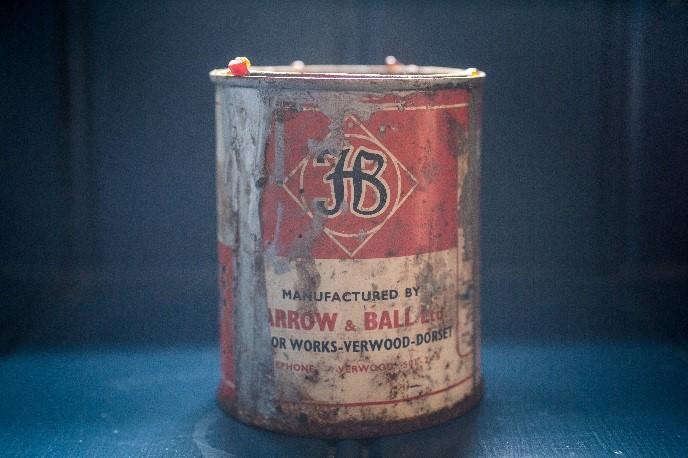
A similar example of using the age of the brand in marketing was demonstrated by the financial services company, Northern trust that lived through many economic recessions and is presently more than 120 years old (Keller 88). Evolution and development is also a vital component of the brand, which is demonstrated by the stylistic changes in the logo (see fig. 2).
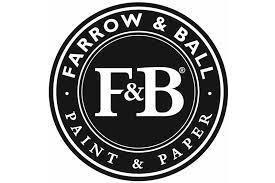
Many similar logos with letters within the circle and minimum colors exist, yet currently, there is a trend for such retro-style designs. Simple colors, white letters on a black background symbolize honesty, transparency, and reliability. Keller underlines the importance of color choices for both package and logo as research identifies the existence of a certain “color vocabulary” (138). Thus, certain colors can contribute to the success or demise of sales.
The choice of colors may seem odd, considering the products the company manufactures. However, a rich color palette present on the logo is rather typical for companies that sell paints. For instance, Dulux, a well-known brand that trades architectural paint and the main competitor for Farrow and Ball features a rainbow-colored wave. With a modest logo, the Farrow and Ball appear to distinguish themselves from their competitors.
The package uses pastel colors, a mixture of dark-grey, dark-red, and white or downpipe, red earth, and shadow white according to the company’s terminology (see fig. 3). Here the same principle applies – traditions, heritage, and retro design. The principle of outdatedness of the design, in this case, cannot be applied as “old-school” has now become trendy again in multiple spheres. Considering the company’s key marketing points, the design choices seem justified.
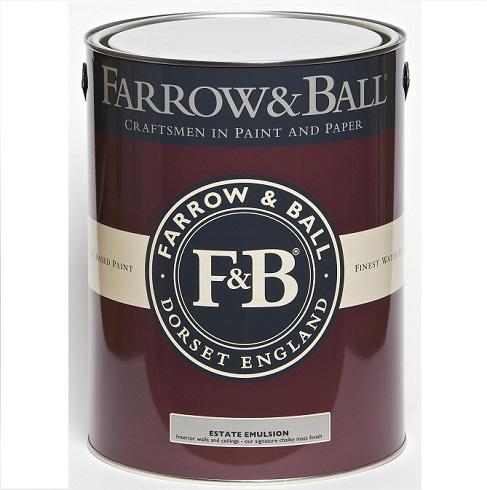
As for matching the criteria for brand elements identified by Keller (114), the brand fits most of them. In terms of being memorable, the brand does not stand out as similar logo designs, and color choices are applied everywhere on the market. Nonetheless, it can be considered likable, as it is straightforward and brief with no excessive brightness, which contributes to its aesthetic qualities. The brand is meaningful as the essential information about the products of the company is listed on the logo and packaging.
The brand is easily transferable as the name of the company does not represent any complex notions that may have different, unpleasant meanings in other cultures. This is additionally proved by the global representation of Farrow and Ball and its relative success around the world. The brand is inflexible as does not come in variations. The brand is protected legally by copyright.
Competitive Environment
As for the competition, Farrow and Ball have several main rivals. Among the most serious ones is Dulux. Dulux is also a well-established brand with a long history yet with different marketing strategies. Dulux takes pride in participating and organizing social events such as AkzoNobel Colour Futures and Colour of the Year (About Dulux). With Farrow and Ball, they share the target audience – the people who are eager to renovate or restyle their houses or apartments. Both companies operate mostly in Britain, yet are represented around the world, and therefore compete for customers globally.
One of the key differences between their products is the price. As noted by Robertson, five liters of estate emulsion by Farrow and Ball would cost 74.50 pounds, while the Dulux equivalent would be only 26. This difference means different marketing strategies. In these conditions, for Farrow and Ball, the key marketing goal would be to convince the buyer that their 75-pound can of paint worth every penny and is significantly better than what Dulux offers.
Brand Positioning
According to Keller (270), brand positioning is comprised of four key elements such as present customers’ considerations about the brand, the firm’s present considerations, and future ideas about the brand from both sides. Regarding the first, the brand is likely to be associated with quality, premium, and rich colors, and also, high price (Morley). The firm identifies itself as a traditional, high quality, eco-friendly, premium, and a digitalized and innovative company (Our History). In the future, the customers may envision Farrow and Ball as more flexible, and adaptive. The firm believes that in the future it should build towards wider operations (Farrow & Ball Limited: Strategic Report 1).
Brand Inventory
Brand inventory is another part of the brand audit comprised of multiple elements that allow having a better insight into the company. It lets to research current marketing and branding activities that Farrow and Ball undertake. The elements that will be discussed in this part constitute symbols, images, packaging, online representation, merchandise, and responsibility.
Symbols
Among symbols that Farrow and Ball use there are a brush and a butterfly. The brush represents creativity and serves as a symbol of inspiration on a website that is created by Farrow and Ball for forming a community (see fig. 4). It is also used to awake the desire to renovate and re-style in their customers. Those who visit this website might be more tempted to repaint the exterior or interior walls or ceiling.

Another symbol used by the company is a butterfly (see fig. 5). A butterfly can symbolize rebirth, considering the natural cycle of the insect’s life and the emergence of something new. This symbol and meaning particularly suite the marketing strategy of the new colors that were recently introduced by the company. Besides, a butterfly can symbolize the richness of colors as these insects usually have brightly pigmented wings. All this complements the sales strategy aimed at stirring up the interest in new products.

Images
The images that the company uses represent mostly interiors and exteriors that feature furniture and household items (see fig. 6). The images are intended to appeal to the customer’s aesthetic feelings as the former represents excellent works of design with all of the elements matching each other. The idea behind them is to motivate the customer to replicate such state-of-the-art interiors and exteriors in his or her house for which they would require Farrow and Ball’s merchandise. On the other hand, these images work for branding as well. They connect the aesthetically pleasing items with the brand and form the perception of elegancy, style, and good taste – the terms which apply to those who buy their products.
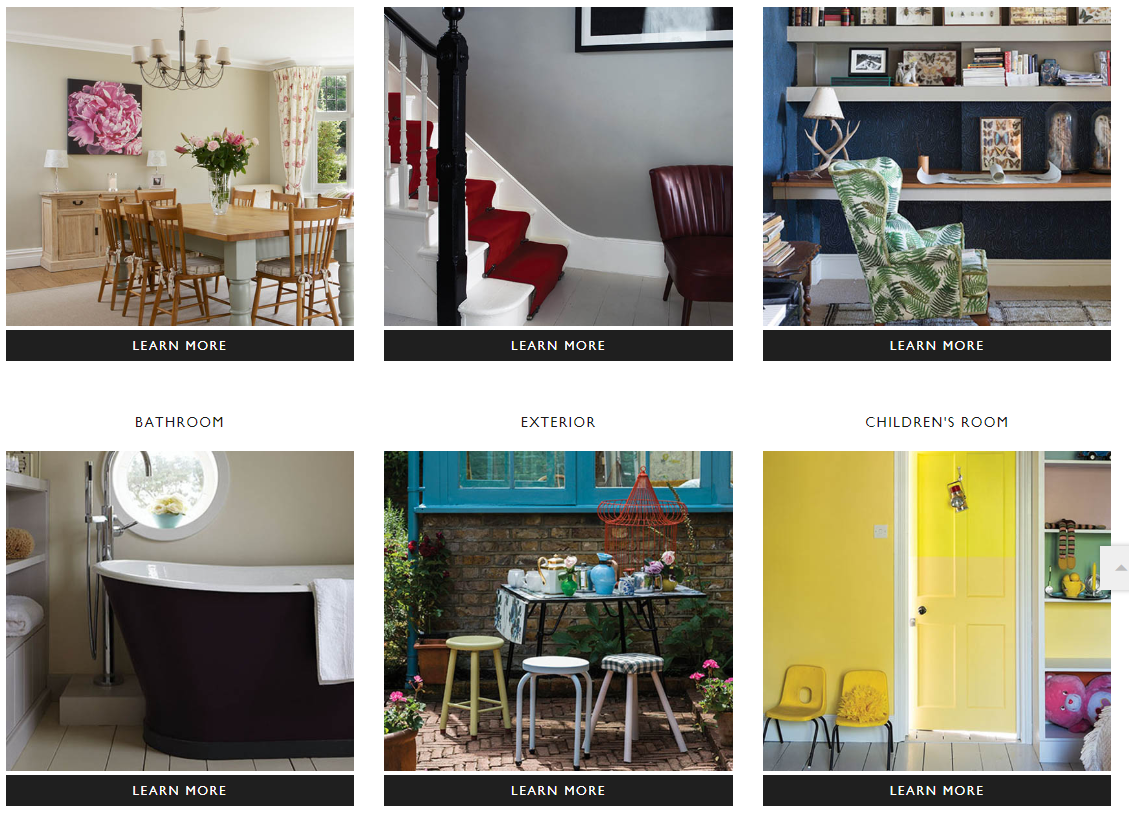
Packaging
The illustration of a package can be seen in figure three presented above. Simple design with a logo on top of the can seems to be an updated version of the original package. It symbolizes a deep concern for heritage and, at the same time reflects the trend for minimalism in design that became very popular recently. In addition to that, like any other item of the brand, the design of the packaging serves as an icon of good taste.
Online Representation
In the twenty-first century, the internet became a major commercial platform. A website became a necessity for each company that planned to expand and become recognized around the world. In 1999, Farrow and Ball decided to launch a website to advertise, market, and sell their products globally (Our History). Its present design can be seen in figure 7. As a vital tool in the company’s marketing and branding strategy, the website is neatly designed. The colors used on each page match the paints that the company manufactures and sells. The website functions as a platform for selling and advertising its products and services. It has gained a fair amount of popularity with 500,000 unique visitors monthly (Our History). The main website also features a range of smaller projects for building a community as it was mentioned above.
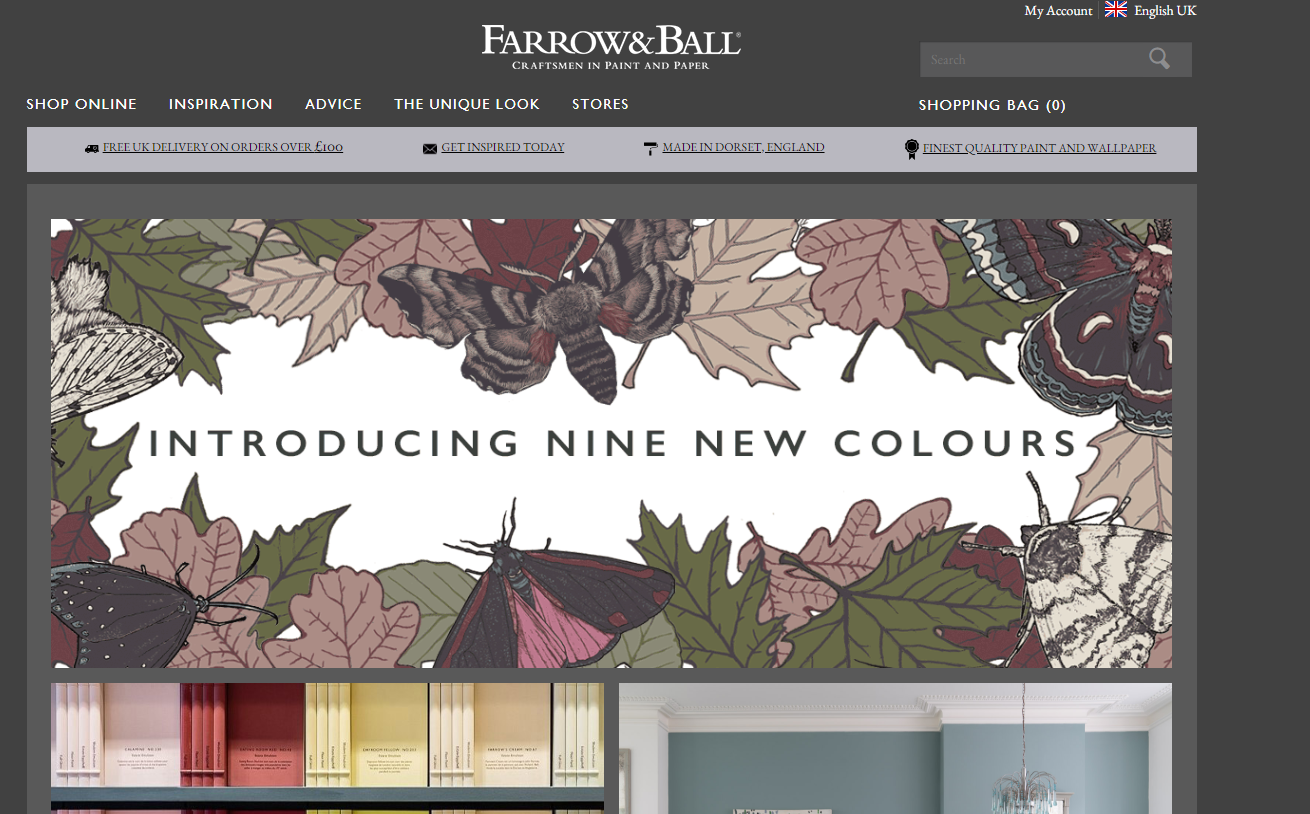
The company also has a Facebook page, Twitter, Instagram, and YouTube accounts where the representatives of Farrow and Ball announce news and events and sell products. Facebook seems to be rather successful with almost 500,000 likes and 480 thousand followers (Farrow & Ball – Home). Twitter account has 50,000 followers, Instagram 454,000, and YouTube – 3,600. Judging by the number of people interested in the company content, the key information channels are the website, Facebook, and Instagram accounts.
Merchandise
The company sells paints presented by 132 different colors and 12 different finishes that can be chosen online, through the color book or color card distributed through stores and showrooms. The average price of a five-liter can of paint is 75 pounds. The company also sells brushes, rollers, and trays for applying paint. Additionally, primers and undercoats can be purchased in stores and online. Another key product line is wallpapered in 50 different patterns (Farrow & Ball – Wallpapers). Wallpaper paste is also available in stores and online. Farrow and Ball also sell three books about design and decoration priced 30 pounds each. For people who want professional advice on decoration, Farrow and Ball offer services of color and design experts.
Development Strategy
Based on the brand exploratory and inventory, it can be safe to say that the company is rather experienced in conducting business in its niche and makes good progress in developing as an enterprise. To that argument speaks the company’s strategic report in which Farrow and Ball indicate increases in sales, turnover, and revenues, which indicates strong marketing and branding efforts (Farrow & Ball Limited: Strategic Report 1). Nonetheless, there is always room for growth and innovation.
One of the most significant contributors to increasing sales through marketing, in this case, would be the justification of the high price. It may be self-evident to high-end customers, but many middle-class buyers may hesitate to buy a 75-pound can of paint instead of a 26-pound one (Morley). Besides, Farrow and Ball faced criticism for its paint formula that was exposed in the media (Morley; Robertson). It can be considered is a serious reputation blow. Concerning the said issues, it could be proposed that the company needs an update of its marketing policy and include activities that will sway the buyers’ into the right choice.
The company’s product range, as identified above includes items that people buy for decorating their houses. Considering that, the company may offer other products and services for this goal. All-round service from selecting the paint to applying it on the desired surface could help the company increase brand loyalty. According to Keller personas may be rather useful in developing the interest of buyers in a brand (271). From the analysis of the images that Farrow and Ball use it can be seen that they do not feature people. By adding archetypical buyers to the photographs of the interiors and exteriors, the company may “bring the target consumer to life.” That initiative will allow the customers to see themselves enjoying the beauty of their hypothetical house through such images.
In conclusion, Farrow and Ball is a successful company with a well-established brand. Its products are sold well throughout Britain and in 36 other countries. It implements solid marketing and branding strategies, but they can be further improved. By adjusting its marketing and branding strategies to explain to the customers the difference between their products and the alternatives, they could profit by attracting new middle-class buyers. The use of personas and offering new services could become useful for the brand as well.
Works Cited
About Dulux. Dulux, 2014. Web.
Dakers, Marion. “Farrow & Ball Finds Quaint Paints Pay off as Profits Rise.” The Telegraph. 2016. Web.
Farrow & Ball – Home. Facebook, 2018. Web.
Farrow & Ball – Wallpapers. Farrow & Ball, 2018. Web.
Farrow & Ball Limited: Strategic Report. Companies House, n.d. Web.
Gram‐Hanssen, Kirsten, and Claus Bech‐Danielsen. “House, Home and Identity from a Consumption Perspective.” Housing, Theory and Society, vol. 21, no. 1, 2006, pp. 17-26.
Keller, Kevin L. Strategic Brand Management. 4th ed., Prentice Hall, 2013.
Morley, Katie. “Exclusive: Farrow & Ball Improves Paint Formula after Criticism.” The Telegraph. 2017. Web.
Our History. Farrow & Ball, 2018. Web.
Robertson, Debora. “The Truth about Farrow & Ball – The Paint We Love to Hate.” The Telegraph. 2017. Web.